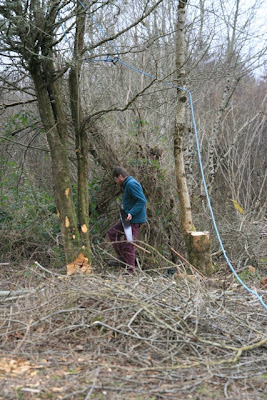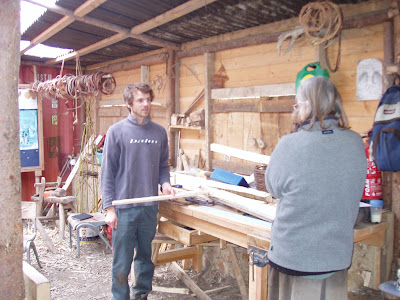Until coffee time on Wednesday we were on the plot. The plan was to learn to pleach hazel stems that had been left when felling with the hope that these would then form new stools. I had already done this as a volunteer and then again with Martin when we shared a large hazel and some of the small stems had got damaged or bent so had to be pleached to keep them safe. I therefore asked to do faggot making. I have a lot of material on my garden which needs clearing up and some of it is for faggots. Martin showed me how to use the ‘woodsman’s grip’ to tie the bundles tightly and we discussed the possibility of using bungee cord if I am working in the shed. A small but useful exercise.
Then we all got on with our projects as time is now limited. With Martin’s help I sourced some Ash for the seat slats and split short, thin planks which I tidied up with the side axe. Essentially the same process as we used to make the benches for the shavehorses but on a smalller scale. It was good to get in more practice with the side axe – there is something about me and axes which doesn’t quite click it seems. I had finally smoothed about half of them with the drawknife when it was time to go home. Andrew and I left slightly early because we had all been invited to Nick and Barbara’s for a celebration meal and both of us wanted to get home to deal with animals before returning. Andrew’s wife, Keridwen had been invited to thank her for the steady stream of delicious cakes which she has sent.
The get together was great. Nick and Barbara’s house is as warm, welcoming, homely and unpretentiously stylish as I would have expected. William Morris would be proud of them – everything was both beautiful and useful. They had cooked a delicious vegetarian feast and I had made a vegan (because Bruce and Cathy had hoped to be there but Bruce was ill) and gluten free (Barbara is gluten intolerant) cake in the shape of a log with an axe, a gate and a robin to represent the one who visits the shelter in search of crumbs from our lunches. A warm fire, comfy seats, good food and good company – a lovely end to the course.
Thursday was slightly fraught for me because my car had to go to the garage for service and MOT . Gravell’s computer had had a hissy fit and forgotten to remind me so when I realised the MOT was due there was no choice of dates. Gravells is in the opposite direction to Cilgerran so I had to take the car one way, pick up a courtesy car and retrace most of my route then on to the woods. I also had to leave promptly to get the cars swopped before they closed for the Easter break. I had hoped to savour the end of the course but was rather distracted so I was particularly glad that we had had the event the previous evening.
With advice and help from Nick and Martin my swing bench was finished by lunchtime. I have still to build a framework for it to hang from at home but I have most of what I need to do that. Andrew very kindly brought his large Landrover and between us he, I, Nick and Barbara carried the seat up the ride and got it in. Because of the necessity to get the courtesy car back to Narberth Andrew took the seat home and delivered it to my place on the Friday morning. I spent the Easter weekend building the frame and after a trip to Crymych for chains and some extra fixings it was installed by Tuesday evening.
 |
| Penny's finished gate |
 |
| Sue's swing seat in place |
On the Thursday afternoon I picked up a discarded piece of cleft Ash, shaped it into a blank for the pole lathe with the side axe just for more practice and then mounted it on the lathe and turned it into a spurtle. It’s the first time I have done the entire process without help so a result!
I came on the course to learn how to manage my own trees safely and now I can. But I have gained so much more. According to the certificate I was given on Thursday afternoon I have demonstrated competence in:
Care and maintenance of hand tools
Cutting and management of a coppice plot
Tree identification
Felling trees safely using an axe and crosscut saw
Selection, cleaving and shaping of green wood
Construction of a saw horse, shave horse and other devices
Pole lathe turning
Charcoal burning
Hedgelaying
Identifying uses for coppice product
Design and construction of a craft project using coppiced materials
I feel a bit of a fraud in that competence may be pushing it a bit on some of those! I have had a go at all of them and whilst I have a lot to learn I know much more than I did. On the learning progression Unconscious incompetence – Conscious incompetence – Conscious competence – Unconscious competence I am between conscious incompetence and conscious competence with different aspects ahead of, or behind, the pack. Since my husband died I have had rather a lot of experience of conscious incompetence as I have taken on responsibilities that I used to leave to him. I don’t like the feeling and struggle with it. The team have identified that I tend to react by being impatient and rushing, ‘taking a run at it’ which, with their help I am learning to curb. Their patient, generous, loving support has enabled me to do things I never thought I could.
Could I have done all this for free by volunteering? Maybe. But on winter Wednesdays the focus of the tutors is on the students – volunteers who have not done the course help by snedding, fetching and carrying. It is only if the course is undersubscribed or the students have all achieved competence in whatever is being practiced that there is time for volunteers to be taught new skills. In summer there is more teaching of green woodwork and charcoal burning but this is all geared towards selling products to raise funds or maintaining the infrastructure, so there is no opportunity to do a project and saw horses or shavehorses are only made when existing ones need replacing.
Quite apart from the skills officially taught I have learned about myself, spent time with a diverse and fascinating group of people, had wide ranging discussions on an array of topics which have challenged my ideas and broadened my horizons and all in a beautiful place. If I could afford it I would do the course again next year and no doubt gain a lot from it. As it is I will continue to volunteer regularly to practice what I have learned, make use of the generous ‘after sales service’ to ask questions and tap into the experience and expertise of the team, and hopefully be more useful to them and to next year’s students.
PS I have taken a week off from volunteering for Coppicewood to go to Dyfed Permaculture Farm Trust and spend a day learning to graft apple trees with Philip Batten. Another lovely day out and a new skill to add to my repertoire!
Words by Sue Laverack























